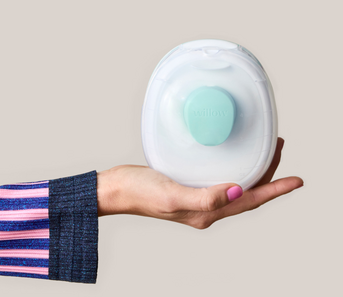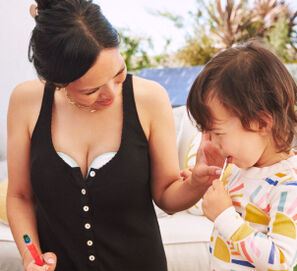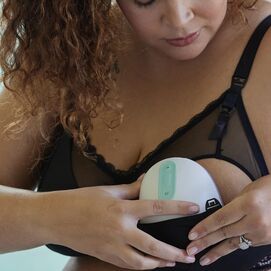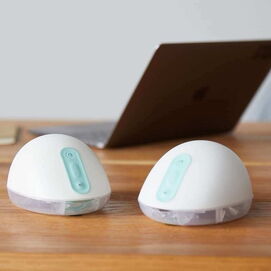Are you expecting a second baby, mama? Congrats! This is a time to enjoy and prepare, especially if you plan on breastfeeding your second baby.
Concerned about breastfeeding again? Worried you won’t be able to breastfeed your second baby since you didn’t breastfeed your first? You have nothing to worry about. Just like each baby, every breastfeeding experience is different. Keep reading to learn more.
Is Breastfeeding Easier the Second Time Around?
Some mamas experience a difficult breastfeeding journey with their first baby, from low milk supply to latch issues. Could breastfeeding be easier the second time around? Sometimes! Since every breastfeeding experience is different, your second time around can be different too.
This is true even if you didn’t make enough milk for your first baby. Researchers have found that moms who breastfeed their second babies have a good chance of giving their babies all the milk they need. In that study, moms made significantly more milk for their second babies when compared to their first.
Your worries are valid, mom. But please know that you may have true success when breastfeeding your second baby. Hopefully, we can help with the following tips.
How to Prepare for Successful Breastfeeding With Second Baby
We know you’re a seasoned pro, especially after having your first baby. Yet, we do have a few tips you can use to make breastfeeding your second baby easier. Let’s jump right in.
Meet With a Lactation Consultant
We recommend reaching out to a lactation consultant first and foremost. During your meeting, you can discuss the struggles you have with your first baby and how you’re feeling about breastfeeding the second.
Your lactation consultant will work to determine if there’s something else that may have contributed to a difficult breastfeeding experience with your first go around. They’ll also help you develop a plan to remedy any underlying issues and to help you stay on track if things get rough again.
Tip: Need to find a lactation consultant near you? Try the USLCA directory or type “lactation consultant near me” into Google.
Check In With Yourself
It’s important to check in with yourself too, mama. Your wellbeing is just as important as your new baby’s. If you’re feeling anxious about attempting nursing again, a consultant can validate those emotions and steer you in the right direction.
Please know, however, that if you suffered a traumatic breastfeeding experience, it’s also okay to be fearful of breastfeeding again. If you’re unable to try again, you shouldn’t feel guilty about making that choice. A fed baby is a happy baby and you should do what you feel is best for both of you.
Reach Out to a Support Person
If you decide to breastfeed again, it might be a great idea to have a support person available to help you after the birth of your baby. This could be a spouse, partner, family member or friend. Ask your support person to help you take care of your other child while you breastfeed, so you and your new baby can get used to the process.
Skin-to-Skin Contact After Birth
Skin-to-skin contact means so much more than uninterrupted cuddle time with your new baby. It can also lead to better breastfeeding when you return home. According to the World Health Organization, 90 minutes of uninterrupted skin-to-skin contact after birth maximizes the chance for babies to be physically ready to breastfeed.
Skin-to-skin contact stimulates the part of your baby’s brain that inspires them to want to eat. Plus, skin-to-skin contact helps build a natural bond with your baby, which is important when breastfeeding.
Track Baby Growth
“Is my baby getting enough milk?”
It’s one of the biggest worries mamas have, especially those who struggled to breastfeed their first babies. The simplest way to tell is by tracking your baby’s growth. You can find helpful growth charts on the web to help you do so.
It’s important to remember that every baby is different and will follow their own curve. If you feel your baby isn’t gaining weight or isn’t making enough wet diapers in a day, there’s a chance they may need more milk.
It’s best to speak to your doctor about any weight or growth concerns that you have regarding your baby. And if you determine your milk supply is low, reach out to your lactation consultant for help. Don’t give up!
Willow 360™ Wearable Breast Pump
Willow 360™ Wearable Breast Pump
Willow 360 is designed with a zero-gravity latch to give you 360° of leak-proof mobility. It's the hands-free breast pump that changed the game.
Willow Go™ Wearable Breast Pump
Willow Go™ Wearable Breast Pump
With hospital-grade suction and a 100% comfort rating, Willow Go pumps quietly and discreetly (no dangling tubes, bottles, or external motors) so you can do it all.
Breastfeeding Second Baby With a Toddler
Do you have a curious toddler? Breastfeeding a baby with a toddler around can be a challenge at times. Yet, there are some things you can do to ease the transition for big bro or sis and you.
-
Talk to your toddler before your baby is born: You can help prepare your big kid by explaining what happens when the baby is born and what you’ll need to do to feed him or her.
-
Ask your toddler to help: It’s normal for toddlers to feel a bit jealous when it comes to a new little one. Reassure your toddler that he or she is important by asking them to help you out. Ask them to hand you the baby’s bottle or allow them to help you burp the baby.
-
Allow them to be curious: Toddlers are naturally curious. If your toddler asks questions about what the new baby is doing while breastfeeding, answer them. Let them check out your breast pump if you’re pumping. This helps your toddler get used to the process.
-
Give them something special to do as you breastfeed: Does your toddler have a favorite book? Read it to them as you breastfeed. Sing a favorite silly song together or allow your toddler to play with a new toy that’s specifically for feeding time. It’s just another way of ensuring they don’t feel left out.
-
Ask for help from your support person: This is a great time for your support person to step in and help you care for your toddler while you breastfeed. This can also go both ways. Ask your support person to snuggle the baby for a bit as you and your toddler spend some quality time together.
Tandem Nursing
If you’re still breastfeeding your toddler, you don’t have to wean them to breastfeed your new baby too. You can breastfeed both through tandem nursing, if you choose to do so.
To make it work, make sure you allow your newborn to breastfeed first, so they receive the colostrum during the first weeks after birth. It’s also important to eat plenty of good food and drink lots of water. After all, you’re making and using a lot of milk.
Oat Mama Lactation Tea
Oat Mama Lactation Tea
Caffeine-free and artfully blended with the best organic, milk-boosting herbs to support a healthy supply on your pumping and nursing journey.
Breastfeeding Second Baby But Not First
Whether you chose not to breastfeed your first baby or you struggled to get started, you can still breastfeed your second baby. If this is your first time trying to breastfeed, here are a few helpful tips to get you started:
-
Reach out for support: Before your baby is born, reach out to a lactation consultant who can help set you up for breastfeeding success. It’s also a good idea to meet with the consultant regularly after birth, so you can share your frustrations and get back on track.
-
Be patient: Breastfeeding is a journey and every baby is different. You must be patient as you learn the ropes. If you start to worry about your supply, look for cues of low supply such as a lack of wet diapers or irritability after feeding. And if something doesn’t seem right, call your doctor or lactation consultant.
-
Purchase a good breast pump: If you plan to feed your baby on the go or if you want to bottle feed, you’ll want a comfortable breast pump that fits your lifestyle. The Willow pump is portable and wearable for easy pumping from anywhere.
-
Look for hunger cues: Keep an eye out for your baby’s hunger cues, especially if you’re breastfeeding on demand. Your baby may lick their lips, root (turn their head and open their mouth) or put their hand to their mouth to suck. Most babies eat every 2-4 hours for the first little while.
-
Learn how to relax: For the best breastfeeding experience, you’ll need to relax during feeding sessions. This will help trigger your letdown reflex and get your milk flowing. Start by cuddling your baby and taking some deep breaths. You might even listen to some relaxing music or close your eyes. You should feel letdown happen quickly.
Have More Questions About Breastfeeding? We Can Help!
Want to know more about breastfeeding? Have questions you need answers to? We can help. Check out our blog for more information and insights. Or, if you’re ready to improve how you breastfeed, shop Willow today.
















